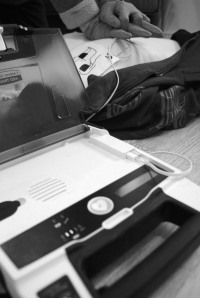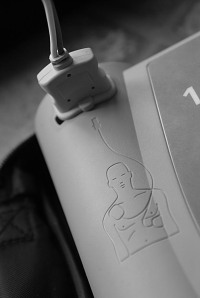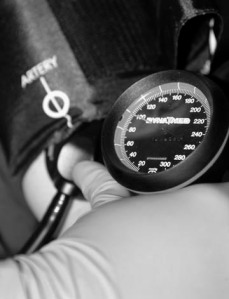Duration of resuscitation efforts and survival after in-hospital cardiac arrest: an observational study
The Lancet, Early Online Publication
Are we performing resuscitation for long enough? In this study the authors wanted to know for in-hospital cardiac arrests, how long resuscitation attempts should be continued before termination of efforts. While this is an in-hospital study, the answer could be relevant for pre-hospital guidelines. The authors investigated whether duration of resuscitation attempts varied between hospitals and whether patients at hospitals that attempt resuscitation for longer have higher survival rates than do those at hospitals with shorter durations of resuscitation efforts.
Between 2000 and 2008, 64,339 patients with cardiac arrests were identified at 435 US hospitals within the Get with the Guidelines – Resuscitation registry. For each hospital, the median duration of resuscitation before termination of efforts in non-survivors was. Multilevel regression models were used to assess the association between the length of resuscitation attempts and risk-adjusted survival. Primary endpoints were immediate survival with return of spontaneous circulation (ROSC) during cardiac arrest and survival to hospital discharge.
31,198 of 64,339 (48·5%) patients achieved return of spontaneous circulation and 9,912 (15·4%) survived to discharge. For patients achieving return of spontaneous circulation, the median duration of resuscitation was 12 min compared with 20 min for non-survivors. Compared with patients at hospitals in the quartile with the shortest median resuscitation attempts in non-survivors (16 min), those at hospitals in the quartile with the longest attempts (25 min) had a higher likelihood of return of spontaneous circulation and survival to discharge.
It was found that duration of resuscitation attempts varies between hospitals. The authors believe that although they cannot define an optimum duration for resuscitation attempts on the basis of these observational data, their findings suggest that efforts to systematically increase the duration of resuscitation could improve survival in this high-risk population.
According to the Australian Resuscitation Council, there is substantial variability in the approaches to termination of resuscitation attempts during cardiac arrest management and factors taken into account include whether the arrest was witnessed, whether bystander CPR was provided, the duration of cardiac arrest, and associated co-morbidities. Just looking to the US for examples of their termination of resuscitation recommendations, while advanced level providers have a minimum time of 20 minutes specified, basic level providers can terminate after 6 minutes (3 full rounds) of CPR and AED analysis.
A large proportion of pre-hospital guidelines specify that resuscitation cannot be terminated until after 20 minutes of ALS care, which once you include the initial CPR, defibrillation, venous access and airway management skills would probably amount to a resuscitation time of 25 minutes or longer which would follow the study’s findings of a greater likelihood of survival and ROSC. However, where there are no guidelines specifying time limits, or those that follow the ‘no ROSC within 3 full cycles of CPR and AED analysis’ rule, should be we saying that these ambulance crews should be staying on scene for longer (maybe even 20 – 25 minutes), especially when considering the poor effectiveness of CPR during extrication and in a moving ambulance.
http://www.thelancet.com/journals/lancet/article/PIIS0140-6736(12)60862-9/abstract
While on the subject of poor effectiveness of CPR, a recent study has found that fatigue can affect chest compression delivery within the second minute of CPR, providing more evidence of the importance of, wherever possible, changing the chest compression provider after every rhythm analysis..
Rescuer fatigue under the 2010 ERC guidelines and its effect on cardiopulmonary resuscitation (CPR) performance
Emerg Med J 2012 Published online
This study sought to determine the impact of the 2010 resuscitation guidelines on rescuer fatigue and cardiopulmonary resuscitation (CPR) performance.
62 Health science students performed 5 min of conventional CPR in accordance with the 2010 ERC guidelines. A SkillReporter manikin was used to objectively assess temporal change in determinants of CPR quality. Participants subjectively reported their end-fatigue levels, using a visual analogue scale, and the point at which they believed fatigue was affecting CPR delivery.
49 (79%) participants reported that fatigue affected their CPR performance, at an average of 167 s. End fatigue averaged 49.5/100. The proportion of chest compressions delivered correctly decreased from 52% in min 1 to 39% in min 5, approaching significance. A significant decline in chest compressions reaching the recommended depth occurred between the first (53%) and fifth (38%) min. Almost half this decline (6%) was between the first and second minutes of CPR. Neither chest compression rate, nor rescue breath volume, were affected by rescuer fatigue.
Fatigue affects chest compression delivery within the second minute of CPR under the 2010 ERC guidelines, according to the authors, and is poorly judged by rescuers. Rescuers should, therefore, be encouraged to interchange after 2 min of CPR delivery. Team leaders should be advised to not rely on rescuers to self-report fatigue, and should, instead, monitor for its effects.
http://emj.bmj.com/content/early/2012/07/31/emermed-2012-201610.abstract






